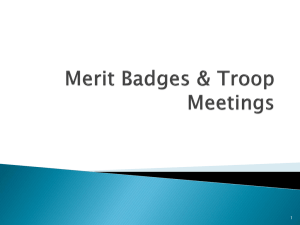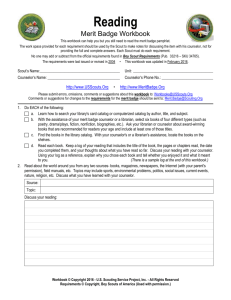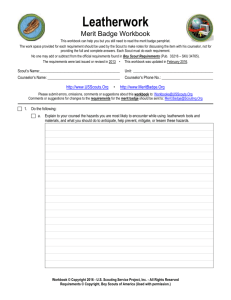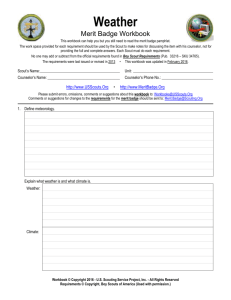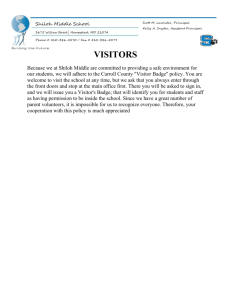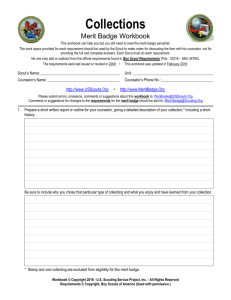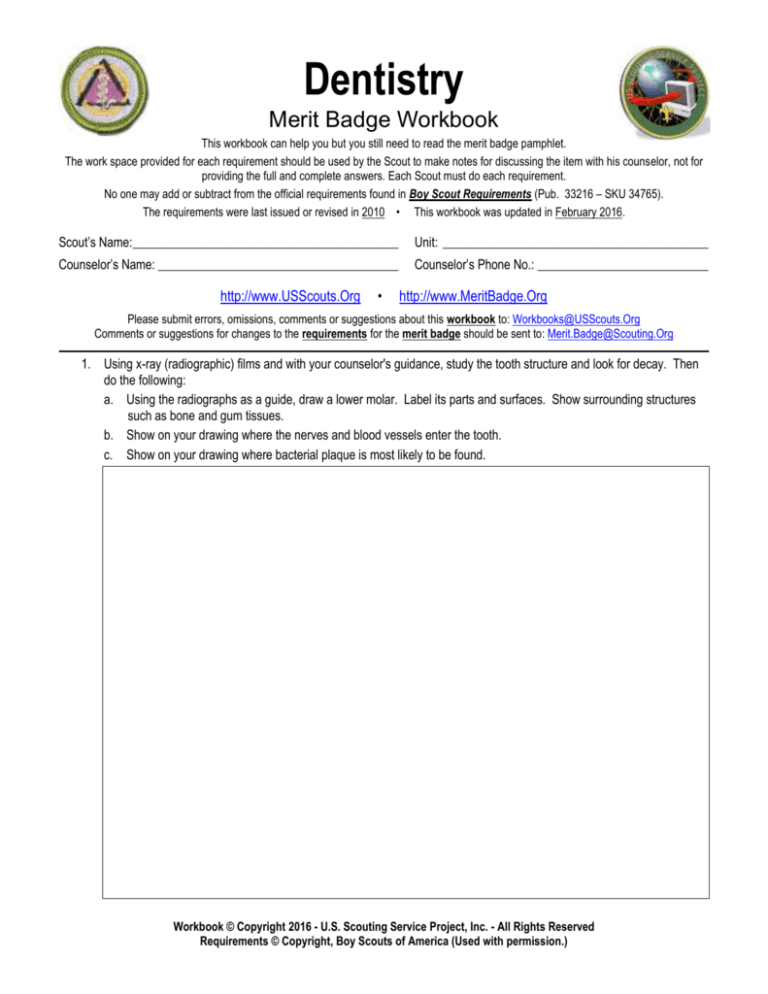
Dentistry
Merit Badge Workbook
This workbook can help you but you still need to read the merit badge pamphlet.
The work space provided for each requirement should be used by the Scout to make notes for discussing the item with his counselor, not for
providing the full and complete answers. Each Scout must do each requirement.
No one may add or subtract from the official requirements found in Boy Scout Requirements (Pub. 33216 – SKU 34765).
The requirements were last issued or revised in 2010 • This workbook was updated in February 2016.
Scout’s Name:__________________________________________
Unit: __________________________________________
Counselor’s Name: ______________________________________
Counselor’s Phone No.: ___________________________
http://www.USScouts.Org
•
http://www.MeritBadge.Org
Please submit errors, omissions, comments or suggestions about this workbook to: Workbooks@USScouts.Org
Comments or suggestions for changes to the requirements for the merit badge should be sent to: Merit.Badge@Scouting.Org
______________________________________________________________________________________________________________________________________________
1. Using x-ray (radiographic) films and with your counselor's guidance, study the tooth structure and look for decay. Then
do the following:
a. Using the radiographs as a guide, draw a lower molar. Label its parts and surfaces. Show surrounding structures
such as bone and gum tissues.
b. Show on your drawing where the nerves and blood vessels enter the tooth.
c. Show on your drawing where bacterial plaque is most likely to be found.
Workbook © Copyright 2016 - U.S. Scouting Service Project, Inc. - All Rights Reserved
Requirements © Copyright, Boy Scouts of America (Used with permission.)
Dentistry
Scout's Name: ________________________
2. Do the following:
a. Tell or write about what causes dental decay and gum disease.
Tell how each of the following contributes to dental decay and gum disease: bacterial plaque, sugars, and acid.
Bacterial plaque:
Sugars,
Acid:
Dentistry - Merit Badge Workbook
Page. 2 of 10
Dentistry
Scout's Name: ________________________
b. Tell the possible causes for traumatic tooth loss, describe the types of mouth guards used to prevent tooth
trauma, and list the athletic activities during which a person should wear a mouth guard.
Causes:
Types of mouth guards:
Athletic activities:
c. Explain the first-aid procedure for saving a tooth that has been knocked out.
d. Discuss how the use of tobacco products can negatively affect your oral health
3. Arrange for a visit with a dentist. Before you go, ask whether your visit can include a dental examination and a plaquecontrol demonstration. Afterward, ask questions about things you want to know.
Dentistry - Merit Badge Workbook
Page. 3 of 10
Dentistry
Scout's Name: ________________________
Then tell your counselor what the dentist does in a checkup examination.
4. Do TWO of the following:
a. Name at least five instruments and five pieces of equipment a dentist uses.
Instruments
Equipment
1.
2.
3.
4.
5.
b. With the help of a dentist, prepare a dental stone cast using a vibrator, a mixing bowl, a water measure, a
plastic measure, model stone, and a spatula.
c. Keep a record of everything you eat for three days. Circle those items that could provide the sugars that
bacterial plaque needs to make acid.
Day 1
Dentistry - Merit Badge Workbook
Day 2
Day 3
Page. 4 of 10
Dentistry
Scout's Name: ________________________
List snacks that you should avoid to help maintain the best oral health.
5. Discuss with your merit badge counselor the following:
a. How fluorides help prevent tooth decay and the ways fluorides can be provided to the teeth.
How fluorides help
prevent tooth
decay
The ways fluorides
can be provided to
the teeth
Dentistry - Merit Badge Workbook
Page. 5 of 10
Dentistry
Scout's Name: ________________________
b. How the mouth is related to the rest of the body. Topics might include chewing, saliva, enzymes, nutrition, and
speech.
Chewing:
Saliva:
Enzymes:
Nutrition:
Speech:
6. Do TWO of the following:
a. Make a model tooth of soap, clay, papier-mâché, or wax. Using a string and a large hand brush, show your
troop or a school class proper toothbrushing and flossing procedures.
b. Make a poster on prevention of dental disease. Show the importance of good oral health.
Dentistry - Merit Badge Workbook
Page. 6 of 10
Dentistry
Scout's Name: ________________________
c. Collect at least five advertisements for different toothpastes. List the claims that each one makes. Tell about
the accuracy of the advertisements.
1.
2.
3.
4.
5.
d. Write a feature story for your school newspaper on the proper care of teeth and gums.
Dentistry - Merit Badge Workbook
Page. 7 of 10
Dentistry
Scout's Name: ________________________
e. Make drawings and write about the progress of dental decay.
Describe the types of dental filling and treatments a dentist can use to repair dental decay problems.
Types of
dental filling
Treatments a
dentist can
use to repair
dental decay
problems
Dentistry - Merit Badge Workbook
Page. 8 of 10
Dentistry
Scout's Name: ________________________
7. Find out about three career opportunities in dentistry.
1.
2.
3.
Pick one and find out the education, training, and experience required for this profession.
Career:
Education:
Training:
Experience:
Discuss this with your counselor, and explain why this profession might interest you.
Requirement resources can be found here:
http://www.meritbadge.org/wiki/index.php/Dentistry#Requirement resources
Dentistry - Merit Badge Workbook
Page. 9 of 10
Important excerpts from the Guide To Advancement - 2013, No. 33088 (SKU-618673)
[1.0.0.0] — Introduction
The current edition of the Guide to Advancement is the official source for administering advancement in all Boy Scouts of America programs: Cub
Scouting, Boy Scouting, Varsity Scouting, Venturing, and Sea Scouts. It replaces any previous BSA advancement manuals, including Advancement
Committee Policies and Procedures, Advancement and Recognition Policies and Procedures, and previous editions of the Guide to Advancement.
[Page 2, and 5.0.1.4] — Policy on Unauthorized Changes to Advancement Program
No council, committee, district, unit, or individual has the authority to add to, or subtract from, advancement requirements. There are limited
exceptions relating only to youth members with special needs. For details see section 10, “Advancement for Members With Special Needs”.
[Page 2] — The “Guide to Safe Scouting” Applies
Policies and procedures outlined in the Guide to Safe Scouting, No. 34416, apply to all BSA activities, including those related to advancement and
Eagle Scout service projects.
[7.0.3.1] — The Buddy System and Certifying Completion
A youth member must not meet one-on-one with an adult. Sessions with counselors must take place where others can view the interaction, or the
Scout must have a buddy: a friend, parent, guardian, brother, sister, or other relative—or better yet, another Scout working on the same badge—along
with him attending the session.
When the Scout meets with the counselor, he should bring any required projects. If these cannot be transported, he should present evidence, such as
photographs or adult verification. His unit leader, for example, might state that a satisfactory bridge or tower has been built for the Pioneering merit
badge, or that meals were prepared for Cooking. If there are questions that requirements were met, a counselor may confirm with adults involved.
Once satisfied, the counselor signs the blue card using the date upon which the Scout completed the requirements, or in the case of partials, initials
the individual requirements passed.
Note that from time to time, it may be appropriate for a requirement that has been met for one badge to also count for another. See “Fulfilling More
Than One Requirement With a Single Activity,” 4.2.3.6.
[7.0.3.2] — Group Instruction
It is acceptable—and sometimes desirable—for merit badges to be taught in group settings. This often occurs at camp and merit badge midways or
similar events. Interactive group discussions can support learning. The method can also be attractive to “guest experts” assisting registered and
approved counselors. Slide shows, skits, demonstrations, panels, and various other techniques can also be employed, but as any teacher can attest,
not everyone will learn all the material.
There must be attention to each individual’s projects and his fulfillment of all requirements. We must know that every Scout —actually and
personally— completed them. If, for example, a requirement uses words like “show,” “demonstrate,” or “discuss,” then every Scout must do that. It is
unacceptable to award badges on the basis of sitting in classrooms watching demonstrations, or remaining silent during discussions.
It is sometimes reported that Scouts who have received merit badges through group instructional settings have not fulfilled all the requirements. To
offer a quality merit badge program, council and district advancement committees should ensure the following are in place for all group instructional
events.
Merit badge counselors are known to be registered and approved.
Any guest experts or guest speakers, or others assisting who are not registered and approved as merit badge counselors, do not accept the
responsibilities of, or behave as, merit badge counselors, either at a group instructional event or at any other time. Their service is temporary, not
ongoing.
Counselors agree not to assume prerequisites have been completed without some level of evidence that the work has been done. Pictures and
letters from other merit badge counselors or unit leaders are the best form of prerequisite documentation when the actual work done cannot be
brought to the camp or site of the merit badge event.
There is a mechanism for unit leaders or others to report concerns to a council advancement committee on summer camp merit badge programs,
group instructional events, and any other merit badge counseling issues—especially in instances where it is believed BSA procedures are not
followed. See “Reporting Merit Badge Counseling Concerns,” 11.1.0.0.
There must be attention to each individual’s projects and his fulfillment of all requirements. We must know that every Scout—actually and
personally—completed them.
[7.0.3.3] — Partial Completions
A Scout need not pass all the requirements of one merit badge with the same counselor. It may be that due to timing or location issues, etc., he must
meet with a different counselor to finish the badge. The Application for Merit Badge has a place to record what has been finished—a “partial.” In the
center section on the reverse of the blue card, the counselor initials for each requirement passed. In the case of a partial completion, the counselor
does not retain his or her portion of the card. A subsequent counselor may choose not to accept partial work, but this should be rare. A Scout, if he
believes he is being treated unfairly, may work with his unit leader to find another counselor. An example for the use of a signed partial would be to
take it to camp as proof of prerequisites. Partials have no expiration except the Scout’s 18th birthday. Units, districts, or councils shall not establish
other expiration dates for partial merit badges.
[7.0.4.8] — Unofficial Worksheets and Learning Aids
Worksheets and other materials that may be of assistance in earning merit badges are available from a variety of places including unofficial sources
on the Internet and even troop libraries. Use of these aids is permissible as long as the materials can be correlated with the current requirements that
Scouts must fulfill. Completing “worksheets” may suffice where a requirement calls for something in writing, but this would not work for a requirement
where the Scout must discuss, tell, show, or demonstrate, etc. Note that Scouts shall not be required to use these learning aids in order to complete a
merit badge.
Attachment
(NOTE: It is not necessary to print this page.)
Page 10 of 10


